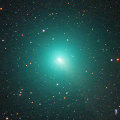
|
It approached to the earth down to 0.12 A.U. and brightened up to 4.6 mag in October (Oct. 18, Juan Jose Gonzalez). It was very large, double of the full moon, and very bright, visible with naked eyes. Now it is fading, but still bright as 4.8 mag (Nov. 4, Juan Jose Gonzalez). After this, it keeps observable for a long time until 2011 June when it fades down to 17 mag.
Date(TT) R.A. (2000) Decl. Delta r Elong. m1 Best Time(A, h)
Nov. 6 7 11.95 4 22.9 0.162 1.066 113 5.3 4:12 ( 0, 60)
Nov. 13 7 27.50 -4 17.2 0.194 1.081 113 5.7 4:00 ( 0, 51)
|

|
Bright new comet discovered visually by Kaoru Ikeya and Shigeki Murakami. It locates near by Saturn in the morning sky. It looks similar to 17P/Holmes. So it seems to be soon after an outburst.
Date(TT) R.A. (2000) Decl. Delta r Elong. m1 Best Time(A, h)
Nov. 6 12 40.58 -2 46.0 2.492 1.745 32 8.3 4:59 (284, 14)
Nov. 13 12 58.37 -5 6.6 2.473 1.756 34 8.4 5:05 (288, 16)
|

|
It has kept bright as 8.5 mag since July until September. It is still bright as 10.4 mag (Oct. 28, Marco Goiato). It will be fading after this, but it will be visible visually until December.
Date(TT) R.A. (2000) Decl. Delta r Elong. m1 Best Time(A, h)
Nov. 6 1 7.74 -17 22.3 1.022 1.888 139 12.2 22:05 ( 0, 38)
Nov. 13 1 7.00 -16 3.4 1.104 1.930 134 12.6 21:37 ( 0, 39)
|
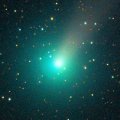
|
It brightened up to 7.9 mag in April and May (May 5, Juan Jose Gonzalez). Now it is fading. But it is still bright as 11.3 mag (Oct. 18, Juan Jose Gonzalez). It keeps observable for a long time until when it fades out in the Northern Hemisphere. It is not observable in the Southern Hemisphere.
Date(TT) R.A. (2000) Decl. Delta r Elong. m1 Best Time(A, h)
Nov. 6 7 9.01 51 11.6 2.298 2.887 117 13.0 4:10 (180, 74)
Nov. 13 6 49.96 50 55.1 2.268 2.958 125 13.2 3:24 (180, 74)
|
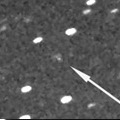
|
The condition in this apparition is bad. It keeps unobservable for a while. In the Southern Hemisphere, it will appear in the morning sky at 12.5 mag in February, then it keeps observable while fading gradually. In the Northern Hemisphere, it is not observable until when it fades down to 15 mag.
Date(TT) R.A. (2000) Decl. Delta r Elong. m1 Best Time(A, h)
Nov. 6 14 9.50 -8 19.0 2.612 1.651 11 13.5 4:59 (275, -7)
Nov. 13 14 28.60 -10 19.1 2.575 1.625 12 13.3 5:05 (279, -5)
|

|
Paul Camilleri reported that it was not visible, fainter than 14-15 mag, on Sept. 29. Hidetaka Sato reported that it was not visible on Oct. 8, the nuclear magnitude must be fainter than 18 mag. It was expected to be bright as 13 mag still now, but actually, it seems to have been already disintegrated. Hirohisa Sato reported that it kept visible in the SWAN images until Sept. 6.
Date(TT) R.A. (2000) Decl. Delta r Elong. m1 Best Time(A, h)
Nov. 6 11 43.71 -62 36.3 2.837 2.430 56 13.4 4:59 (336,-17)
Nov. 13 11 55.55 -65 40.7 2.918 2.529 57 13.7 5:05 (340,-18)
|

|
Already bright as 12.8 mag (Oct. 29, Marco Goiato). It is expected to keep so bright as 6-8 mag for a long time from 2011 to 2012, and to be observable in good condition in the Northern Hemisphere. In 2010, it is observable in good condition in the Southern Hemisphere while brightening slowly. It locates low in the Northern Hemisphere, but it keeps observable until the end of 2010.
Date(TT) R.A. (2000) Decl. Delta r Elong. m1 Best Time(A, h)
Nov. 6 22 2.99 -35 6.6 4.800 5.008 96 13.6 19:01 ( 0, 20)
Nov. 13 21 59.72 -34 17.5 4.853 4.944 89 13.6 18:30 ( 0, 21)
|
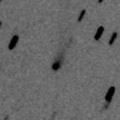
|
Now it is 14.4 mag, much brighter than originally expected (Oct. 17, S. Shurpakou). It keeps observable in good condition from autumn to next spring. It will brighten up to 13 mag and will be visible visually.
Date(TT) R.A. (2000) Decl. Delta r Elong. m1 Best Time(A, h)
Nov. 6 7 36.29 13 49.6 2.608 3.085 109 13.9 4:37 ( 0, 69)
Nov. 13 7 29.14 11 34.1 2.477 3.065 117 13.8 4:02 ( 0, 67)
|
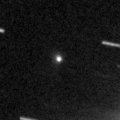
|
Now it is 13.3 mag, much brighter than expected and visible visually (Oct. 18, Juan Jose Gonzalez). In the Northern Hemisphere, it will be observable at 13-14 ag in good condition from autumn to winter. In the Southern Hemisphere, it will be unobservable until 2011 spring.
Date(TT) R.A. (2000) Decl. Delta r Elong. m1 Best Time(A, h)
Nov. 6 17 50.33 64 33.7 2.523 2.677 87 14.1 18:27 (149, 46)
Nov. 13 18 24.99 61 30.7 2.494 2.653 88 14.0 18:23 (146, 48)
|

|
Now it is bright as 14.4 mag (Oct. 10, Ken-ichi Kadota).
Date(TT) R.A. (2000) Decl. Delta r Elong. m1 Best Time(A, h)
Nov. 6 11 3.35 1 53.8 6.719 6.237 57 14.1 4:59 (297, 36)
Nov. 13 11 6.51 1 26.3 6.620 6.238 63 14.1 5:05 (304, 41)
|

|
It reached up to 7.7 mag in last summer (2009 Aug. 13, Chris Wyatt). It is fading now. It has already faded down to 13.2 mag (Sept. 6, Chris Wyatt). In the Southern Hemisphere, it keeps observable for a long time after this. In the Northern Hemisphere, it will never be observable again.
Date(TT) R.A. (2000) Decl. Delta r Elong. m1 Best Time(A, h)
Nov. 6 17 23.38 -47 19.2 6.088 5.440 45 14.3 18:27 ( 37, -9)
Nov. 13 17 26.86 -47 28.4 6.202 5.487 40 14.4 18:23 ( 39,-12)
|

|
The condition of this apparition is bad. It has not been observable at all around the maximum brightness. However, it is appearing in the morning sky now. Now it is 13.0 mag (Sept. 25, Ken-ichi Kadota). It keeps observable after this while fading gradually.
Date(TT) R.A. (2000) Decl. Delta r Elong. m1 Best Time(A, h)
Nov. 6 11 42.04 -11 21.2 2.504 1.922 44 14.3 4:59 (300, 20)
Nov. 13 11 54.58 -13 5.2 2.497 1.970 47 14.5 5:05 (306, 22)
|

|
It brightened up to 11.5 mag in July (July 18, Juan Jose Gonzalez). Now it is 13.6 mag (Oct. 26, Marco Goiato). Fading slowly. It will keep 14 mag until the end of 2010. It is observable in excellent condition in the Southern Hemisphere. It locates somewhat low in the Northern Hemisphere.
Date(TT) R.A. (2000) Decl. Delta r Elong. m1 Best Time(A, h)
Nov. 6 21 4.62 -27 59.4 2.724 2.852 87 14.4 18:27 ( 6, 27)
Nov. 13 21 12.24 -27 7.6 2.835 2.872 82 14.6 18:23 ( 10, 27)
|

|
It is already bright as 13.8 mag and visible visually (Sept. 10, Chris Wyatt). It will be observable at 13-14 mag for a long time from 2011 to 2012. It will be getting lower gradually in the evening sky after this. It will be unobservable in November in the Southern Hemisphere, or in December in the Northern Hemisphere.
Date(TT) R.A. (2000) Decl. Delta r Elong. m1 Best Time(A, h)
Nov. 6 20 9.68 -6 2.1 6.555 6.461 80 15.2 18:27 ( 29, 45)
Nov. 13 20 8.77 -6 20.7 6.648 6.431 73 15.2 18:23 ( 36, 42)
|
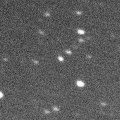
|
Now it is 14.8 mag (June 23, Hidetaka Sato). It keeps bright as 14-15 mag for a long time after this until 2013. It is not observable in the Northern Hemisphere. It will be low temporarily in November in the Southern Hemisphere. It must be bright, however, no observations have been reported since early July.
Date(TT) R.A. (2000) Decl. Delta r Elong. m1 Best Time(A, h)
Nov. 6 15 2.29 -51 40.8 7.032 6.257 36 15.2 18:27 ( 46,-31)
Nov. 13 15 8.06 -52 23.3 7.023 6.233 34 15.2 5:05 (315,-32)
|

|
Now it is bright as 14.2 mag and visible visually (Sept. 5, Sandor Szabo). It will be fading very slowly after this. In the Northern Hemisphere, it keeps observable for a long time until 2012 spring when it fades down to 17-18 mag.In the Southern Hemisphere, it will never be observable after this.
Date(TT) R.A. (2000) Decl. Delta r Elong. m1 Best Time(A, h)
Nov. 6 18 21.52 33 13.6 4.737 4.521 71 15.4 18:27 (101, 52)
Nov. 13 18 30.14 32 48.3 4.779 4.526 69 15.5 18:23 (102, 49)
|

|
Now it is 16.4 mag (Oct. 20, M. Jaeger, E. Prosperi, W. Vollmann). It will pass the perihelion on Nov. 25. In the Northern Hemisphere, it is observable until early November when it brightens up to 16 mag, and after mid December while fading from 16 mag. It will not be observable in the Southern Hemisphere.
Date(TT) R.A. (2000) Decl. Delta r Elong. m1 Best Time(A, h)
Nov. 6 12 8.37 -4 34.0 0.787 0.634 39 15.9 4:59 (291, 20)
Nov. 13 13 17.37 -13 16.6 0.833 0.464 27 15.6 5:05 (292, 7)
|

|
Now it is 15.7 mag (Oct. 2, Ken-ichi Kadota). It is observable at 15.5 mag in good condition from autumn to winter. It locates somewhat low in the Southern Hemisphere.
Date(TT) R.A. (2000) Decl. Delta r Elong. m1 Best Time(A, h)
Nov. 6 6 55.29 25 25.8 1.455 2.140 120 15.8 3:56 ( 0, 80)
Nov. 13 6 58.15 27 6.1 1.398 2.147 127 15.7 3:31 ( 0, 82)
|

|
Now it is 16.5 mag (Oct. 5, Hidetaka Sato). It keeps 16 mag until the end of 2010. It keeps observable in good condition in the Southern Hemisphere. But it is not observable at all in the Northern Hemisphere.
Date(TT) R.A. (2000) Decl. Delta r Elong. m1 Best Time(A, h)
Nov. 6 7 0.26 -76 19.5 2.739 2.753 80 16.1 4:01 ( 0,-21)
Nov. 13 5 51.20 -79 0.4 2.743 2.762 80 16.1 2:26 ( 0,-24)
|
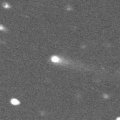
|
Now it is 17.2 mag (Oct. 6, Ken-ichi Kadota). It was observed at 16 mag from late 2009 to early 2010. It has already passed the perihelion, however, it tends to be brightest after the perihelion passage. It will be observable at 16 mag again in good condition from late 2010 to early 2011.
Date(TT) R.A. (2000) Decl. Delta r Elong. m1 Best Time(A, h)
Nov. 6 10 11.89 9 51.5 3.665 3.488 71 16.2 4:59 (302, 51)
Nov. 13 10 17.41 9 14.8 3.581 3.502 77 16.1 5:05 (311, 55)
|

|
Now it is 15.7 mag (Nov. 5, Hidetaka Sato). A bit brighter than predicted. It keeps 16 mag until 2011 spring. It keeps observable in good condition in the Southern Hemisphere. But in the Northern Hemisphere, it locates very low in 2011 spring only.
Date(TT) R.A. (2000) Decl. Delta r Elong. m1 Best Time(A, h)
Nov. 6 11 30.32 -60 49.0 3.265 2.843 56 16.6 4:59 (336,-15)
Nov. 13 11 25.57 -62 6.9 3.225 2.843 58 16.6 5:05 (341,-13)
|

|
Peculiar asteroid moving along a comet-like retrograde orbit. Now it is 17.8 mag (Oct. 6, Paul Camilleri). It brightens up to 16.5 mag in November. It is observable in excellent condition in the Southern Hemisphere. In the Northern Hemisphere, it will become lower rapidly, and will locate extremely low in November.
Date(TT) R.A. (2000) Decl. Delta r Elong. m1 Best Time(A, h)
Nov. 6 4 47.33 -34 13.8 1.093 1.823 121 16.7 1:50 ( 0, 21)
Nov. 13 3 51.77 -40 41.7 1.062 1.784 120 16.6 0:28 ( 0, 15)
|
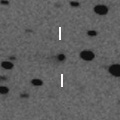
|
Now it is 16.9 mag (Oct. 9, Catalina Sky Survey). It keeps 17 mag for a long time from 2009 to 2012. It is observable in good condition in the Northern Hemisphere. It locates somewhat low in the Southern Hemisphere.
Date(TT) R.A. (2000) Decl. Delta r Elong. m1 Best Time(A, h)
Nov. 6 1 27.12 18 35.5 7.175 8.122 161 16.9 22:24 ( 0, 74)
Nov. 13 1 21.69 18 8.8 7.215 8.115 153 16.9 21:51 ( 0, 73)
|
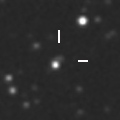
|
Now it is 17.3 mag (Oct. 6, Hidetaka Sato). It is expected to be 15 mag and will be observable in good condition in 2013. It is observable in good condition in the Northern Hemisphere, but not observable in the Southern Hemisphere now.
Date(TT) R.A. (2000) Decl. Delta r Elong. m1 Best Time(A, h)
Nov. 6 2 48.67 61 49.3 7.919 8.637 134 17.4 23:45 (180, 63)
Nov. 13 2 38.78 61 43.3 7.868 8.604 135 17.3 23:08 (180, 63)
|

|
It was observed only during 3 days in 2009 May, then it has been lost. The ephemeris says that it passes the perihelion in 2011 January and it will be observable at 17 mag. But actually, it will not be found.
Date(TT) R.A. (2000) Decl. Delta r Elong. m1 Best Time(A, h)
Nov. 6 8 58.67 -12 33.3 3.937 3.941 83 17.4 4:59 (341, 40)
Nov. 13 8 53.03 -13 36.0 3.804 3.933 90 17.3 5:05 (353, 41)
|

|
Now it is 17.2 mag (Sept. 16, Catalina Sky Survey). It has already passed the perihelion, however, it tends to be brightest after the perihelion passage. In the Northern Hemisphere, it will be observable at 17.5 mag in good condition until the end of 2010. It locates extremely low in the Southern Hemisphere.
Date(TT) R.A. (2000) Decl. Delta r Elong. m1 Best Time(A, h)
Nov. 6 9 9.28 25 37.2 1.934 2.191 91 17.5 4:59 (297, 72)
Nov. 13 9 15.42 24 32.6 1.881 2.222 96 17.5 5:05 (315, 76)
|

|
It had been bright as 13-14 mag for a long time from 2007 to 2009. Now it is fading. It keeps observable at 17.5 mag in good condition until next spring.
Date(TT) R.A. (2000) Decl. Delta r Elong. m1 Best Time(A, h)
Nov. 6 11 59.14 34 41.8 9.411 9.018 63 17.5 4:59 (252, 41)
Nov. 13 11 59.98 34 53.4 9.350 9.053 69 17.5 5:05 (255, 48)
|

|
Large Centaur-type asteroid. It keeps observable at 17-18 mag for a long time until 2013.
Date(TT) R.A. (2000) Decl. Delta r Elong. m1 Best Time(A, h)
Nov. 6 8 26.43 -18 40.6 6.451 6.507 88 17.7 4:59 (352, 36)
Nov. 13 8 25.11 -18 46.8 6.347 6.505 94 17.7 4:58 ( 0, 36)
|
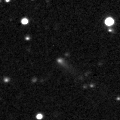
|
Now it is 17.3 mag (Oct. 2, Toru Yusa). It is observable at 17.5 mag in good condition from summer to autumn in the Northern Hemisphere. It locates somewhat low in the Southern Hemisphere.
Date(TT) R.A. (2000) Decl. Delta r Elong. m1 Best Time(A, h)
Nov. 6 0 58.35 25 21.0 0.965 1.905 153 17.7 21:56 ( 0, 80)
Nov. 13 1 0.39 23 17.0 1.006 1.923 148 17.9 21:31 ( 0, 78)
|

|
New comet. Now it is 17.6 mag (Oct. 18, L. Buzzi, S. Foglia), but it will be fainter than 18 mag soon.
Date(TT) R.A. (2000) Decl. Delta r Elong. m1 Best Time(A, h)
Nov. 6 1 48.58 31 3.3 1.597 2.553 160 17.8 22:46 ( 0, 86)
Nov. 13 1 42.80 31 3.0 1.617 2.553 155 17.8 22:12 ( 0, 86)
|
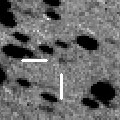
|
Now it is 18.0 mag (Oct. 21, M. Jaeger, E. Prosperi, W. Vollmann). In the Northern Hemisphere, it keeps observable in good condition until 2011 spring when it brightens up to 16 mag. In the Southern Hemisphere, it keeps locating low.
Date(TT) R.A. (2000) Decl. Delta r Elong. m1 Best Time(A, h)
Nov. 6 5 47.00 33 6.4 1.985 2.778 135 18.0 2:48 ( 0, 88)
Nov. 13 5 44.88 33 58.9 1.898 2.748 142 17.8 2:18 ( 0, 89)
|
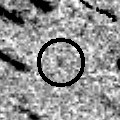
|
It was expected to be bright as 17-18 mag. But actually, it is so faint as 20.3 mag (Oct. 11, Giovanni Sostero and Ermesto Guido). However, it was observed as bright as 17 mag in 1998 and 2005. So it will brighten after the perihelion passage, and will be bright up to 17 mag in 2011-2012 season also in this apparition. In the Northern Hemisphere, it will be observable in good condition while fading gradually after 2011 summer. It is not observable after the perihelion passage in the Southern Hemisphere.
Date(TT) R.A. (2000) Decl. Delta r Elong. m1 Best Time(A, h)
Nov. 6 20 34.45 -33 8.4 2.494 2.511 79 20.2 18:27 ( 12, 21)
Nov. 13 20 42.86 -32 24.8 2.541 2.471 74 20.2 18:23 ( 16, 21)
|
|
![]()
 10P/Tempel 2
10P/Tempel 2 C/2009 K5 ( McNaught )
C/2009 K5 ( McNaught ) 9P/Tempel 1
9P/Tempel 1 C/2009 R1 ( McNaught )
C/2009 R1 ( McNaught ) C/2009 P1 ( Garradd )
C/2009 P1 ( Garradd ) C/2010 B1 ( Cardinal )
C/2010 B1 ( Cardinal ) C/2009 Y1 ( Catalina )
C/2009 Y1 ( Catalina ) 29P/Schwassmann-Wachmann 1
29P/Schwassmann-Wachmann 1 C/2006 W3 ( Christensen )
C/2006 W3 ( Christensen ) 43P/Wolf-Harrington
43P/Wolf-Harrington 65P/Gunn
65P/Gunn C/2006 S3 ( LONEOS )
C/2006 S3 ( LONEOS ) C/2009 F4 ( McNaught )
C/2009 F4 ( McNaught ) C/2008 FK75 ( Lemmon-Siding Spring )
C/2008 FK75 ( Lemmon-Siding Spring ) (3200) Phaethon
(3200) Phaethon 240P/2010 P1 ( NEAT )
240P/2010 P1 ( NEAT ) C/2010 A4 ( Siding Spring )
C/2010 A4 ( Siding Spring ) 203P/2008 R4 ( Korlevic )
203P/2008 R4 ( Korlevic ) C/2010 FB87 ( WISE-Garradd )
C/2010 FB87 ( WISE-Garradd ) 2009 YS6
2009 YS6 C/2008 S3 ( Boattini )
C/2008 S3 ( Boattini ) C/2010 S1 ( LINEAR )
C/2010 S1 ( LINEAR ) C/2009 K3 ( Beshore )
C/2009 K3 ( Beshore ) 241P/2010 P2 ( LINEAR )
241P/2010 P2 ( LINEAR ) C/2005 L3 ( McNaught )
C/2005 L3 ( McNaught ) 2008 YB3
2008 YB3 236P/2010 K1 ( LINEAR )
236P/2010 K1 ( LINEAR ) P/2010 U2 ( Hill )
P/2010 U2 ( Hill ) 123P/West-Hartley
123P/West-Hartley 164P/Christensen
164P/Christensen![]()






















